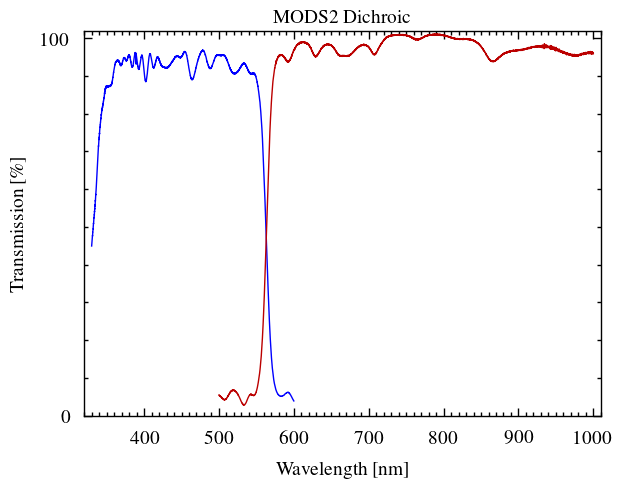Dichroic
The MODS dichroic is the last element of common focal plane optics for the blue and red. This dichroic splits light into red and blue-optimized spectrograph channels, passing blue light and reflecting red light with the 50% cross-over wavelength at 5650Å. The MODS dichroic transmission curves for MODS1 and MODS2 are shown below.
The transmission (blue) and reflection (red; relative to the red folding flat #1) curves were measured by dividing a spectroscopic flat taken in dual grating mode (i.e. with the dichroic in the beam) by one taken in direct grating mode (i.e. with nothing in the beam for the blue channel and with the red folding flat #1 in the beam for the red channel).
The wiggles are real variations in the dichroic transmission/reflection curves, and so they also affect the spectroscopic data. They complicate the reduction, but can be calibrated using observations of spectrophotometric standard stars. A high order fit to the ratio of the observed to tabulated standard star spectrum is needed to determine a sensitivity function which includes these wiggles.
In the dual grating spectra, there will be a small (~50 angstrom) region of reduced signal-to-noise around the dichroic crossover region, which is ~5650 angstroms for MODS1 and ~5630 angstroms for MODS2.
The dichroic transmission, measured with respect to the direct-mode transmission, is provided in the text files linked to the table below. The fact that, for the red channels, this is a relative transmission with respect to the folding flat accounts for the >100% transmission around 7800-7900 angstroms for MODS2.
| Instrument | Blue (transmitted light) | Red (reflected light, relative to folding flat #1) |
| MODS1 | dichroic_mods1b.txt | dichroic_mods1r.txt |
| MODS2 | dichroic_mods2b.txt | dichroic_mods2r.txt |



